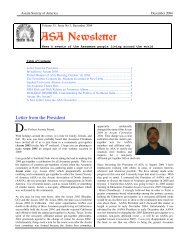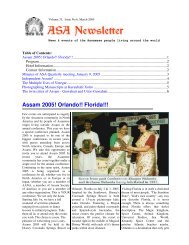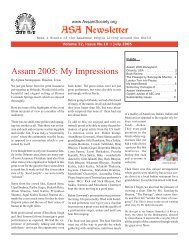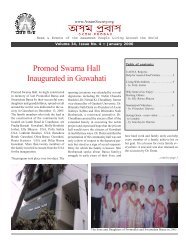June 2007 - Assam.Org
June 2007 - Assam.Org
June 2007 - Assam.Org
Create successful ePaper yourself
Turn your PDF publications into a flip-book with our unique Google optimized e-Paper software.
that the best individuals are attracted.Advertisements should be placed in all-Indiaand international engineering periodicals.Recruitment should be based on merit.<strong>Assam</strong> should be able to recruit 400 to 500engineering professors needed over a periodof several years. Many of the engineeringprofessors working outside <strong>Assam</strong> or abroadwill be encouraged to establish partnershipswith the <strong>Assam</strong> engineering colleges. Theaccomplished faculty will be encouraged totake sabbatical leave from their homeinstitutions and spend time at these collegesto provide leadership and help buildprograms at a minimum cost.12. Curriculum DevelopmentAICTE is the body that approvesengineering programs in India. The newinstitutions have to be approved by AICTE.The institutions can also get accreditationfrom the National Board for Accreditation(NBA) although it is not necessary. In fact,<strong>Assam</strong> has no accredited engineering collegeas of May, 2006. 38 <strong>Assam</strong> should require allinstitutions to obtain NBAaccreditation within, say10 years ofestablishment. In fact,the NBA has haddiscussions with theInstitution for Electricaland ElectronicEngineers (IEEE)regarding accreditationissues lately. 39 In theUS, Engineeringundergraduate programs are accredited byABET 40 after an elaborate process. It willbe advised to ask the engineering collegesin <strong>Assam</strong> to align their curricula as much aspossible with ABET’s requirementsalthough it is not essential to do so. Nonresident<strong>Assam</strong>ese (NRA) in the USA whoare in engineering teaching and research canassist in developing such curricula. It shouldbe of paramount importance to developprograms, which have the potential tobecome national leaders. Some of the Non-Resident <strong>Assam</strong>ese engineering educatorsare already well-linked with other Indianinstitutions and the Government of India inbuilding partnerships. For example, Dr.Prasanta Kalita of the University of Illinoisconsults with the Prime Minister of India’sOffice on engineering education. They willbe happy to connect and build partnershipswith engineering colleges in <strong>Assam</strong>.13. Impact on Local Economies and<strong>Assam</strong>’s EconomyAlmost every engineer in <strong>Assam</strong> of anystripe is from one of <strong>Assam</strong> EngineeringCollege, Jorhat Engineering College or theNational Technical Institute, Silchar.<strong>Assam</strong>ese IIT graduates are a rare breed.There are a substantial number of RegionalEngineering College (now, NationalInstitutes of Technology) graduates from<strong>Assam</strong>, and some from private engineeringcolleges such as Birla Institutes ofTechnology. Engineers from the three localengineering colleges have had tremendousimpact on <strong>Assam</strong>. These three colleges havethousands of alumni all over the worldincluding Bangalore, Hyderabad, Delhi,Pune, US, Canada, Australia and the MiddleEast. The establishment of 11 newengineering colleges in <strong>Assam</strong> (over say, 5or 10 years) will change the perception of<strong>Assam</strong> to its people as well people outside.The recent history of <strong>Assam</strong> has made manypeople unsure of its future although thingsare starting to change for the better. Theestablishment of these engineering collegesin <strong>Assam</strong> will signal that <strong>Assam</strong> wants to bea player in the emerging globalized hi-techeconomy. Each engineering college willprovide a boost to the economy of the localregion. The salaries of the professors, staffmembers and administrators, and the moneyspent by the students will play an upliftingrole, especially in the smaller towns. TheTezpur Universitystudents and the professors will provide rolemodels to others, especially in the ruralareas. Many of the students will leave townafter graduation, migrate to South India orDelhi or abroad. This brain drain is not allthat bad. These people will advance throughtheir careers and will send back money to<strong>Assam</strong> to their families. Many will comeback at a certain point in time to work in<strong>Assam</strong>. Either way, <strong>Assam</strong> will benefit inthe long run. These colleges will teachconcepts of business, innovation andentrepreneurship as well as engineering.Thus, some of these students will be primedto start enterprises in <strong>Assam</strong>. As cities likeBangalore, Pune and Hyderabad becomeexpensive, development in high-tech andother engineering fields will move to smallercities and towns. In fact, the Government ofIndia is actively supporting the developmentof a number of second-tier cities.Information Technology jobs andoutsourced jobs are going to start movinginto these cities in the near future. Theestablishment of these engineering collegeswill get <strong>Assam</strong> ready for this day that willarrive soon. Although it is difficult to predicthow the establishment of the newengineering colleges will impact on <strong>Assam</strong>’sper-capita income in a direct manner, it is awell-established fact that highly educatedPage 12 * POSOOWA, <strong>June</strong> <strong>2007</strong>societies are able to harness human talentand that they have higher per-capita incomesand quality of life.Developing a relationship with alumnishould be a focus of the engineering collegesfrom the very beginning. Keepingconnections with alumni, organizing“Homecoming” events, inviting successfulalumni to give presentations, andencouraging highly placed alumni to recruitstudents should be given priority. A longtermconnection with alumni is also likelyto bring in dividends in terms of money andnon-monetary contributions. Alumnirelations are not a strong point of mostuniversities and colleges in <strong>Assam</strong> at thistime.If additional engineering colleges areestablished in <strong>Assam</strong>, will it lead to growthof software and other high-technologyindustries in <strong>Assam</strong>? The answer is mostcertainly in the affirmative. A recent articleexplains why Infosys, a leading hightechnologycompany in Indiaand the world, hasa 12,000 employees t r o n gdevelopmentcenter inBhubaneswar,Orissa and not inGuwahati, <strong>Assam</strong>a l t h o u g hGuwahati hasbetter air-connectivity, better hotels andother facilities. 41 According to this article,Infosys has several pre-conditions beforestarting development centers in a location,the primary being manpower ability. Orissahad 41 engineering colleges in 2004 with13,000 entering students annually. As aresult, 80% of the employees in the InfosysOrissa development center are from Orissa.According to Infosys chairman, as quotedin this article, if a software developmentcenter is started in Guwahati, employeeshave to be hired from outside <strong>Assam</strong> and itis not cost-effective to do so. The conclusionof the article is that software developmentis manpower intensive and corporations willset up centers where manpower is locallyavailable. By interpolating from theconclusions of this article, it is possible tosurmise that if the new engineering collegesin <strong>Assam</strong> produce a thousand or more newgraduates, it is possible that corporationswill come to <strong>Assam</strong> to recruit them and keepthem in <strong>Assam</strong>.14. How can NRAs Help?Non-resident <strong>Assam</strong>ese individuals in otherparts of India as well abroad should beencouraged to help in the development ofcurricula for these engineering colleges.Many such individuals can act as volunteers
















